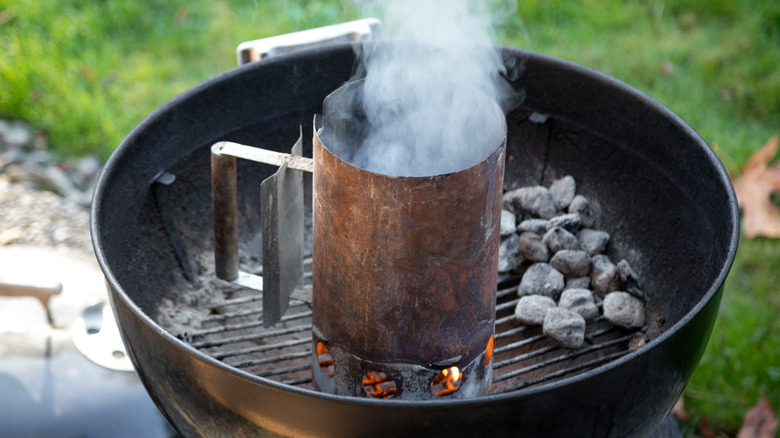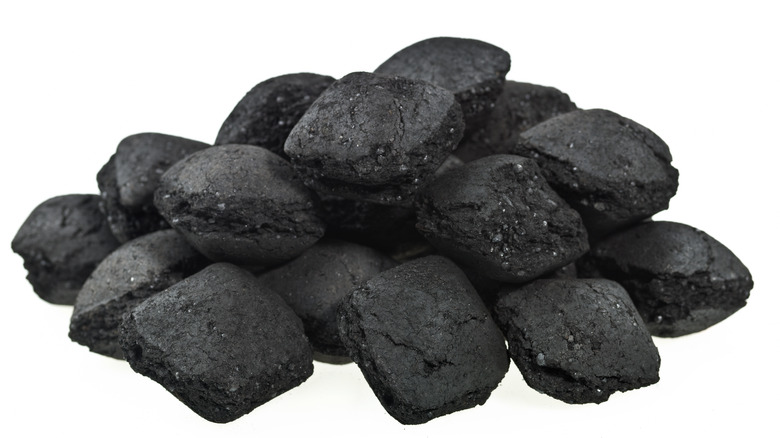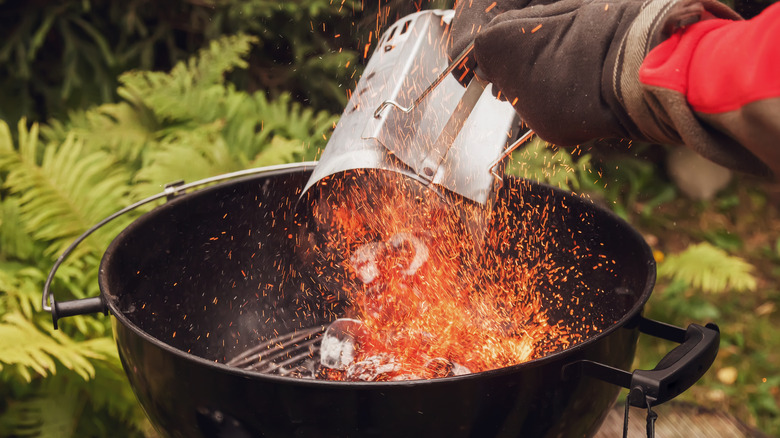What Is A Chimney Grill Starter And How Does It Work?
If you've ever worked with a charcoal barbecue grill, you know the challenges it can present. There are plenty we could talk about, but let's be real: There's one in particular you thought of before anything else. We all know what it is, but let's say it out loud for the members of the class who have never had the dubious pleasure of lighting a charcoal grill: The annoying little carbonized chunks will not catch fire no matter what you do. There are tricks you can rely on if your charcoal grill won't stay lit — putting a paper towel soaked in cooking oil at the bottom of the grill is a pretty good one — but even those have limited success.
Fortunately, there's a product that exists entirely to solve this problem, and it works surprisingly well: a chimney starter. A chimney starter, at its core, is essentially a small bucket with a grated bottom and a handle on it. That's an accurate description, but not a complete one, because what a chimney starter actually is is a lifeline for anyone who wants to grill with charcoal.
Charcoal burns long and hot -- if you can get it lit
To understand why charcoal often doesn't want to stay lit, it's important to understand what charcoal is. It may look like small black rocks, but it's not rocks at all: It's wood. Wait, if it's wood, and wood is highly flammable, then why is lighting charcoal such a problem? Because it's wood that's been heated in low-oxygen conditions to 1,000 degrees Fahrenheit, an appreciable fraction of the surface of the sun. Because the environment is low-oxygen, the wood doesn't simply burn up and turn to ash. Instead it slowly carbonizes over time.
The result is small black chunks of what-was-once-wood that — if you can get them lit — will burn far slower and yet far hotter than regular pieces of wood. That means you don't have to replace your grill's fuel source nearly as quickly as if you were only using logs. "If you can get them lit" is the key phrase here, because getting them lit and keeping them lit is the difficult part. There can be a few reasons for this — maybe the charcoal got wet, or the grill has too much ash in it, or maybe the briquettes are just bad — but the most likely explanation is air flow, and that's where a chimney starter comes in.
Chimney starters work by channeling air to flow where you need It
You might have heard that the easiest way to get charcoal to light is to stack it in something like a pyramid shape. The idea here is that when the bottom coals are exposed to heat, the hot air flows upward, causing the lower coals to heat the ones above them, creating a chain reaction and eventually lighting the whole lot. This works — but it's hard to actually get the coals to stay in formation long enough for the principle to work.
A chimney starter is specifically built to solve this problem. You just pile a bunch of charcoal in it, light a fire on the ground under it with newspaper (this is why the bottom is grated), and wait. The oxygen and smoke have nowhere to go but literally up from the fire under the starter, meaning more oxygen hits the coals, and in no time at all those briquettes will be roaring hot. They all stay lit because it's a self-reinforcing cycle where the more heat gets generated, the more heat keeps being generated.
From there, you pick up the starter by the fireproof handle and dump the flaming coals into the grill. It genuinely could not be simpler and will save you more headaches than you realize. If you're working with a charcoal grill and don't have a chimney starter, go and buy one right now.


